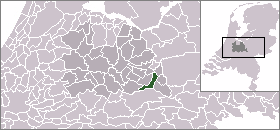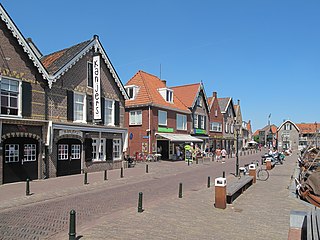
Gorssel is a village in the Dutch province of Gelderland. It is located in the municipality of Lochem, about 6 km southeast of Deventer.

Amerongen is a village in the central Netherlands on the border of the Utrecht Hill Ridge. It lies about 7 km south west of Veenendaal.

Bunschoten is a municipality and a town in the Netherlands, in the province of Utrecht. It lies about 7 km north of Amersfoort. Its territory comprises the original municipality of Bunschoten and the former municipality of Duyst, De Haar and Zevenhuizen, which was a part of Hoogland from 1854 until 1971.

Driebergen is a former village and municipality in the Dutch province of Utrecht. It is first mentioned as Thriberghen in 1159. The former municipality of Driebergen existed until 1931, when it merged with Rijsenburg, to create the new municipality of Driebergen-Rijsenburg. In later years, due to growth of the villages of Driebergen and Rijsenburg, the villages themselves also merged, to become the single town of Driebergen-Rijsenburg. Since 2006, Driebergen-Rijsenburg is part of the new municipality Utrechtse Heuvelrug.

Hooglanderveen is a village in the Dutch province of Utrecht. It is a part of the municipality of Amersfoort, and lies about 4 km northeast of Amersfoort. It is notable for the presence of a large catholic church.

Den Dolder is a town in the Dutch province of Utrecht. It is a part of the municipality of Zeist, and lies about 4 km northeast of Bilthoven. Den Dolder has a railway station on the route between Amersfoort and Utrecht and is best known for its mental institutions such as Dennendal and the Willem Arntz Hoeve. Den Dolder also houses the big Dutch sauce manufacturer Remia referring to Den Dolder as Holland's Heart of Sauces as is depicted on the factory's side and is visible from the train passing by.

Lunteren is a town in Gelderland, the Netherlands. It has a railway station on the line between Amersfoort and Ede.
Pijnacker is a town in the Dutch province of South Holland. It is located about 4 km east of the city of Delft, in the municipality of Pijnacker-Nootdorp.

Hoogmade is a village in the Dutch province of South Holland. It is located about 7 km east of Leiden, in the municipality of Kaag en Braassem.

Spakenburg is a Dutch village north of Bunschoten. Spakenburg is formally called Bunschoten-Spakenburg since its fusion with Bunschoten. The village lies south of the IJsselmeer in the municipality Bunschoten, Utrecht. It is one of the few places left in the Netherlands where some women still wear local traditional clothes.

Langbroek is a town in the Dutch province of Utrecht. It is a part of the municipality of Wijk bij Duurstede, and lies about 11 km southeast of Zeist.

Zevenhuizen is a hamlet in the Dutch province of Utrecht. It is a part of the municipality of Bunschoten, and lies about 6 km north of the centre of Amersfoort. The village consists of a single road, the Zevenhuizerstraat.

Ransdorp is a village in the province of North Holland, Netherlands, part of the municipality of Amsterdam. It lies about 7 km northeast of the city centre, in the Landelijk Noord district. Ransdorp is a part of the borough Amsterdam-Noord and has about 245 inhabitants.
Catharijne is a former municipality on the west side of the Dutch city of Utrecht. It was a separate municipality between 1818 and 1823, when it merged with the city of Utrecht.
Loenen-Kronenburg was a Dutch municipality from 1817 to '19. Its former territory is now part of Loenen in the province of Utrecht.

Loenen is a village in the Dutch province of Gelderland. It is located in the municipality of Apeldoorn, about 10 km southeast of that city.

Vrijhoef en Kalverbroek is a former heerlijkheid (manor) and municipality in the Dutch province of South Holland. It was located about 3 km east of the city of Gouda, in the current municipality of Reeuwijk. The area of the former municipality is now almost completely covered by the lakes of the Reeuwijksche Plassen.

Amersfoort railway station is the main railway station in Amersfoort, in the province of Utrecht, Netherlands. The station was an important link between the western part of the Netherlands and the north and east of the country until December 2012 when the Hanzelijn opened.



















